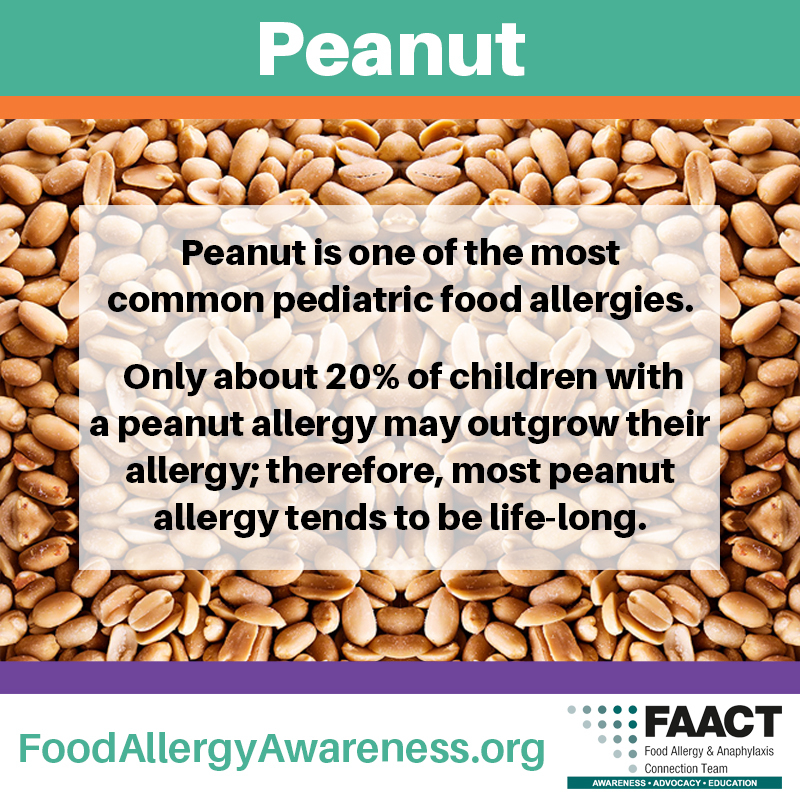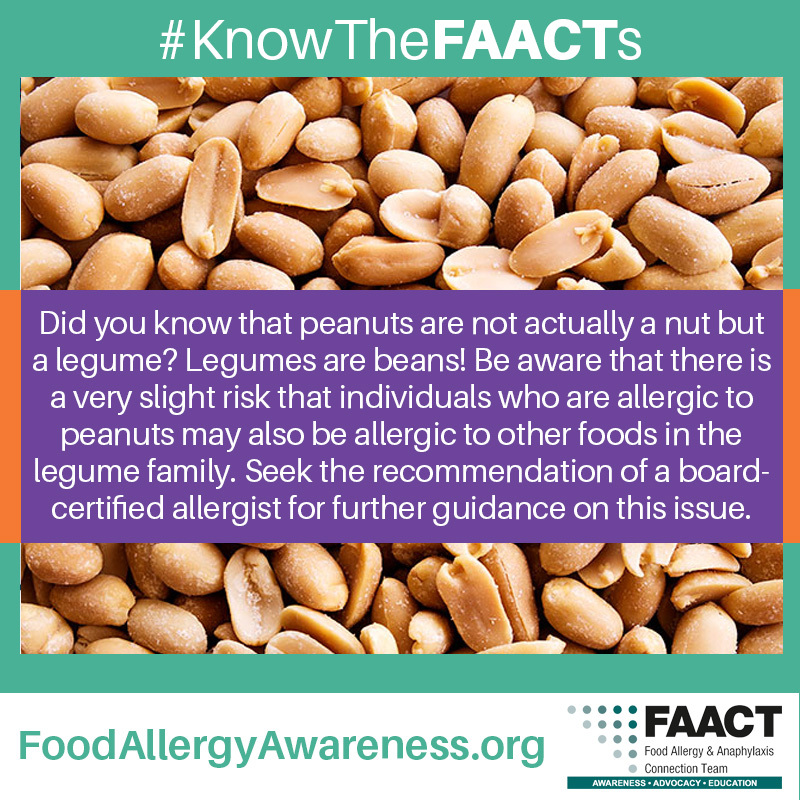Peanuts
Subcategories

Peanuts
Peanut is one of the most common pediatric food allergies.[1] Between 1997-2008, the self-reported rate of peanut allergies tripled from about 0.4% to 1.4%. A 2011 study suggested as many as 2% of children may have peanut allergy. Only about 20% of children with a peanut allergy may outgrow their allergy; therefore, most peanut allergy tends to be life-long.[3] Peanut allergy may results in severe reactions—a 2011 study noted that more than half of those reporting a peanut allergy also reported having a severe reaction to peanut. Therefore, peanut avoidance is exceptionally important. Though not much is known about why individuals die from food allergy, among known cases of such deaths, many of these individuals died from peanut allergy. Please review the “Practical Tips” section for ways to manage peanut allergies if you have been diagnosed.
There are no good answers as to why so many people are developing peanut allergies. One possible theory may relate to how peanut is prepared. In certain parts of the world, peanuts are boiled and fried as opposed to being dry roasted (or defatted to become peanut butter) as is common in the US. Tests have shown that dry roasting and defatting may make peanut more dangerous as an allergen than when it is simply boiled. When peanut is introduced in the diet may also play a role. Data from a study conducted in Israel (where peanut is introduced in the first year of life) and London (where it is delayed until age 3) noted that there were lower rates of allergy in Israel, which was thought to be related to the earlier introduction. This theory is currently being investigated in a large trial in London.
Peanut Allergy: Special Considerations
The need for tree nut avoidance:
Individuals with a peanut diagnosis should seek a board certified allergist recommendation to confirm avoidance of tree nuts due to a peanut allergy. Peanut and tree nut are not from the same family. Peanut is a legume, and tree nuts are drupes. Because both peanut and tree nut have evolved from plants, each carries certain proteins that are shared between peanut, tree nut, and other plants. However, there are other parts of peanut and tree nut that are very similar in structure. On allergy tests, the common proteins and similar structures may be responsible for high rates of co-positive tests when assessing peanut and tree nut individuals for cross-reactivity. Please keep in mind that just having a positive allergy test does not automatically mean that the person is allergic to the item, especially if the person has never eaten the item and developed symptoms. Therefore, a food challenge to the tree nut(s) may be recommended to determine if these items are safe to eat. However, some allergists do recommend total avoidance of all peanut and tree nut due to concerns of cross-contamination. Please check with your allergist for your specific management plan.
The safety of peanut oils:
The safety of peanut oils is controversial. In general MOST (but not all) peanut oil used for cooking purposes is safe. Highly refined commercial peanut oils have been shown to not contain any peanut, and may be considered safe. However, cold pressed and smaller batch peanut oils have been shown to contain varying levels of peanut, and thus are not considered safe. It is difficult to identify the type of oil used to cook a product, however. Therefore, avoidance of peanut oil is often recommended, though it is likely that some peanut allergic patients have tolerated peanut oil. We realize that this may be very confusing, and that more studies are needed to clarify if peanut oils are safe. Please discuss the safety of peanut oils with your board-certified allergist or doctor managing your peanut allergy.
The risk of inhaling peanut and casual environmental contact:
Caregivers and patients often express concern about reacting to peanut through the smell of peanut butter, breathing in peanut dust, or the risk from touching surfaces that may have come in contact with peanut. Inhalation has often been reported as a route through which someone’s reaction has occurred. However, evidence has shown there is a very low to absent risk accidental exposure through casual environmental contact is exceptionally low, and no evidence that shows peanut butter or peanut dust can cause a reaction. Studies have shown that following:
-
Peanut residue can be easily cleaned from hands with soap and water (not hand gel) and from tables with commercial products.
-
Inhaling the scent of peanut butter (within a foot of an open jar) did not cause any reactions.
-
No peanut allergen could be measured at the level of the neck after volunteers stomping on whole peanuts in a small room with no ventilation
-
When actively shelling peanuts, peanut allergen could only be detected 2 cm above the table. However, allergen was not detectable 1m away, and undetectable at either 2cm or 1m immediately upon stopping shelling.
Practical Tips
It is recommended to always carry at least two (2) epinephrine devices at all times if you have been diagnosed with a peanut allergy. This is in case one misfires or if symptoms return and a second dose is needed. If an epinephrine device has been used, always seek emergency medical assistance immediately. This is due to the possibility of a biphasic reaction. A biphasic reaction is when a second wave of a reaction occurs, which is usually stronger than the first. It can occur within 2-4 hours and in some cases, up to 8 hours, after the initial reaction. Stay in medical care for at least 4-6 hours. Strict avoidance of peanuts and products containing peanuts is necessary.
Read all product labels prior to the consumption of a new food product. Before consuming any products, it is important to always read labels carefully to ensure the safety of a food product. All food products that contain peanut protein as an ingredient are required by FALCPA law to list the word “Peanut” on the product label.[2] According to the Food Allergen Labeling and Consumer Protection Act (FALCPA), food products with the advisory statements such as “may contain”, “might contain”, or “manufactured in a shared facility that process” on a package are completely voluntary, and can be ambiguous. The true level of contamination is not declared, and may range from parts per million to micrograms. There may be different risks associated with these levels. It is generally recommended to avoid products with such labeling because of this uncertainty.
Cross-contact from cooking utensils or products like using the same jelly that was used in making a peanut butter and jelly sandwich pose a potential danger. If a knife that was used in the peanut butter was then used in the jelly, the jelly is no longer safe for the peanut allergic individual. A new, clean knife should have been used in the jelly jar (no double dipping). Or a separate, dedicated jelly for the peanut allergic individual may be a safer option. Another example is scraping off peanuts from a meal and serving it to a peanut allergic individual. It is still unsafe for consumption. A new clean plate, with a safe meal, should be served to the peanut allergic individual.
Many tree nuts (almonds, walnuts, pistachio etc.) may be processed with peanut and contain trace amounts of peanut protein if these are not from a single-source facility. In addition, candies and chocolates may be processed with peanuts, and contain trace amounts of peanut protein. Be mindful of smaller or “fun size” version of the larger products. These products are often times manufactured on different equipment and may be exposed to the peanut allergen during this process that are not present in the larger sized bars. It is recommended to read labels and contact the manufacturer to confirm the safety of the products.
Visiting restaurants can be a pleasant experience for family and friends to gather together. However, some restaurants may pose as a risk. Certain restaurants, ice cream shops, and bakeries are considered high risk for individuals with a peanut allergy due to the common use of peanuts as ingredients, as well as the risk of cross-contaminated cooking surfaces and utensils. Please review our restaurant page for tips on how to manage visiting a restaurant. Be vigilant, ask questions, and if there is any doubt, don’t eat the food item in question.
How to Safely Avoid Peanuts
Peanuts can be found in everyday food items. It is important to identify the safety of each item.
We have designated two areas of concern:
1. Foods that commonly use or may contain peanut as an ingredient, so be EXTRA-CAUTIOUS and investigate these products carefully before allowing a peanut-allergic individual to eat them.
2. Foods where peanut can be used as a hidden or unexpected ingredient, so be EXTRA-CAUTIOUS and investigate these products carefully before allowing a peanut-allergic individual to eat them.
Foods that commonly contain or may contain peanut as an ingredient:
- Candies
- Chocolates
- Baked Goods
- Ice Cream
- Trail Mixes
- Specialize candied popcorn (Cracker Jacks and other brands)
- Peanut oils*: Arachic, Arachis, Cold pressed, Expressed, Expelled, Extruded peanut
Foods that may contain peanut as a hidden or unexpected ingredient:
- Egg roll (used binding agent)
- Pet food
- Bird seed
- Crepe filling
- Mole sauce
- Served as waiting area appetizers at certain chain restaurants
- Glazes and marinades
- Graham cracker crusts
- Nougat
- Chili sauces
- Hot sauces
- Pesto
- Gravy
- Some salads may contain peanut
*It is important to check the safety of the products listed. However, some products listed may have safe alternatives. For example, some pancakes are safe for peanut allergic individuals. It is best to check with the manufacturer or restaurant to confirm the safety.
NOTE: Please keep in mind in a culturally diverse world, different ingredients may be used in different recipes. Always use extreme caution.
Other pages that may be of interest:
Visit FAACT's CROSS-CONTACT page to review how to properly clean allergens from hands and surfaces.

FAACT
Did you know that peanuts are not actually a nut but a legume? Legumes are beans! Be aware that there is a very slight risk that individuals who are allergic to peanuts may also be allergic to other foods in the legume family. However, most peanut allergic individuals tolerate other legumes, and it is not generally recommended to avoid other legumes on account of a peanut allergy. We highly recommend that peanut allergic individuals seek the recommendation of a board-certified allergist for further guidance on this issue.

